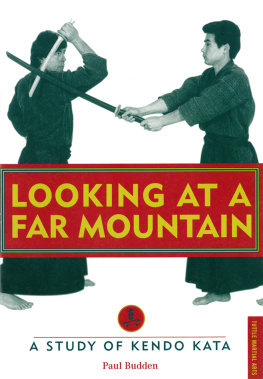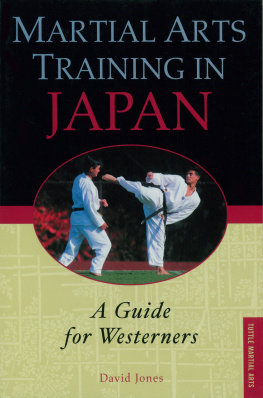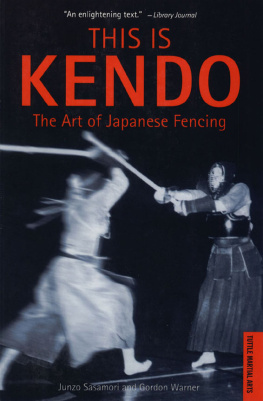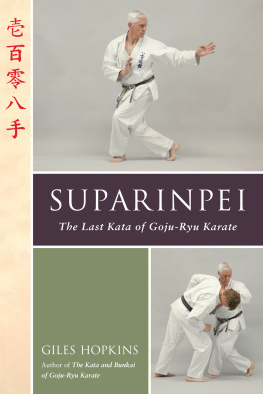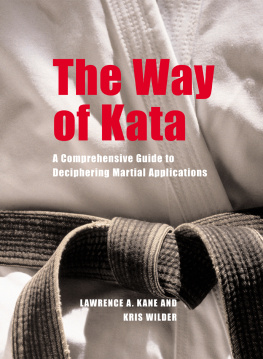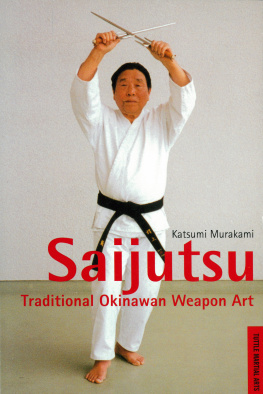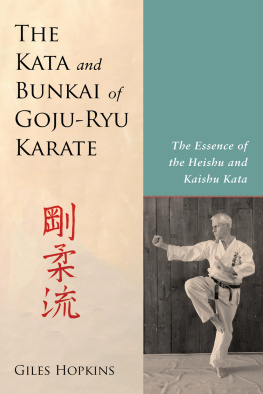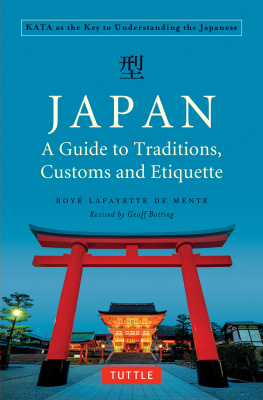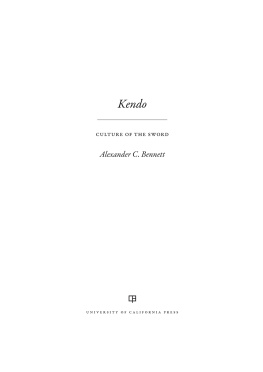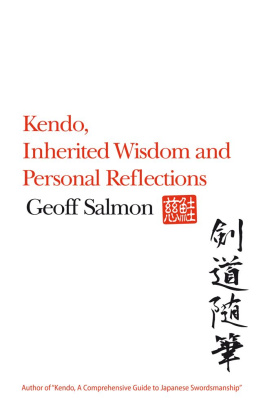ACKNOWLEDGEMENTS
I would like to thank a number of people who have assisted in the bringing about of this study, either with background information and technical expertise, or by just supporting the venture and for putting up and practising with me over the past years.
Special thanks to:
Hideko and Les Denniston
Shoji Enomoto, Associate Professor in Faculty of Art and Letters, Nanzan University, Nagoya, Japan
Victor Harris, Curator Japanese Antiquities, British Museum
Kenji Hirose, Hanshi, Kodokan Kendo Dojo, Kyoto, Japan
Nobuo Hirakawa, Professor Meiji University, Tokyo, Japan
Terry Holt
Masayoshi Imasato, Associate Professor, Kendo Dept. Kyoto Sangyo University, Japan
Takeshi Kudoh, Kyoshi 7th Dan, All Japan Kendo Federation
Brian Kay, Director Eikoku News Digest, London
Jumpei Matsumoto, friend and fellow student in Kendo
Torao Ono, Kyoshi, Seijudo Kendo Dojo, Setagaya, Japan
Hiroyuki Shioiri, Associate Professor, Saitama University, Japan
Masatake Sumi, Professor, Dept. of Health and Physical Education, Fukuoka University of Education, Japan
Dr Haru-Hisa Takamatsu DVM.MS Ph.D
Peter Wells
To Yoshinori Inoue, fellow practitioner of the Kata, Tsuyako Suzuki for all her patience and kindness and to Goro Ohtaki, life long student of Musashi and without whose guidance and friendship this project would never have been attempted.
Humility is indeed endless.
Finally to my wife Helen, for her tolerance and understanding throughout.
Photos in the technical section by Malcom Birkitt.
Books used in reference and photographic reproduction courtesy of Shoji Enomoto.
Jikishin kage Ryu No Kata by Meishin Saito 1901 (Meiji 34)
Budo Hokan-Showa Tenran Shiai Huroku Dai Nihon Yuben Kai 1930 (showa 5)
Shinsei Kendo Kyokasho by Goro Saimura and Kinji Kaneko 1931 (showa 6)
Kai Tei Teikoku Kendo Kyohan by Kinnosuke Ogawa 1937 (showa 12)
Other photos courtesy of Kodansha Ltd., Tokyo, Japan
Pictures of Sasamori sensei via Victor Harris
Front Kanji (Japanese Lettering) by Kenji Hirose
Inside Kanji for Technical section by Tsuyako Suzuki
Note on the origins of the calligraphy illustrating this book:
Kenji Hirose sensei was born in Kyoto in 1905, and joined Kodokan dojo in 1924. His teacher was Kinnoske Ogawa who was not only the founder of Kodokan, but was recognised as one of the greatest kendo teachers of his age. Hirose sensei was a diligent student and studied with sincerity under Ogawa sensei until his teachers death in 1962. Throughout his kendo career he won countless national and local competitions, and now at the age of 85 is still an active member of the same dojo he joined 66 years ago, teaching children and adults alike. He is 7th. dan Hanshi, and one of the most respected kendo teachers in Japan.
CHAPTER ONE
THE KATA TRADITION
In the pre Tokuga era, Kata were referred to as kumitachi and seiho and were the result of the training methods of the classical schools of kenjutsu. However, these methods did not actually become laid down and recorded officially until the period 1560-1572. They were developed from actual fighting techniques as taught by military teachers skilled in their art, and former techniques of classical swordsmanship contain the theory and practical applications necessary to retain the essence of their conception, and are thus vital for further development in all kendoka. In 1886 Meiji (19) the Japanese Police were the first, other than the existing classical schools, to refer to these old forms in order to create a standard kendo kata. In the same year the keishichoryu kata became the standard kata for police use, formed from the schools of Jikishinkage, Kurama, Tsutsumi, Hozan, Risshin, Hokushin Itto, Asayama Ichiden, Jigen , Shinto Munen, Yagyu and Kyoshin Meichi Ryus. It is interesting that the Japanese Police still use the kata system today as a highly beneficial training method, so maintaining the direct link to the origins of classical swordsmanship.
In 1895 Meiji (28) the foundation of the Dai Nihon Butokukai became the controlling body of all budoka throughout Japan, offering unity and attempting to standardise the classical ryuha or schools and sections.
This unification only really began after the war against Russia in 1904, 1905 ( Meiji 37 and 38), through the foundation of the Bujutsu Kyoin Yoseijo (martial arts masters training school), in Kyoto , as research developed new kata in both Judo and Kendo.
In 1906, Meiji (39), Noboru Watanbe was the head of the Dai Nihon Butokukai committee, Hanshi , Shinto Munen Ryu together with Unpachiro Shibae (Hanshi Shinto Munen Ryu), Kanichiro Mitsuhashi (Musashi ryu), Sekishiro Tokuno (hanshi, Jikishin kage ryu), Daisaku Sakabe (hanshi, kyoushin meichi ryu), Shingoro Negishi (Hanshi, Shinto munen ryu), Morie Abe (Jikishin kage ryu), and eight others who were allowed to take part in the discussions: were T Naito, S Sayama, M Toyama, K Yano, K Minatobe, T Yamasato and H Nakayama. In August 1906 the original three kata were decided as the Butokukai Kenjutsu Kata, also known as Ten, Chi, Jin no Kata Heaven, earth and person, or jodan gedan chudan. However, it seems that as very little discussion actually took place there was widespread complaint from the masters, making it unpopular and consequently little is known about this Kata.
In this same period the other leading group was the Tokyo Koto Shihan Gakko, or the teachers training college in Tokyo, with the founder of modern judo, Jigoro Kano, as its headmaster. Tokyo Koto Shihan Gakko organised a seminar and published the original kata of three forms, originated in 1911 by Sasaburo Takano, I Ozawa, S Hoshino, A Tanaka, T Naito, S Negishi, T Shingai, H Nakayama, T Yamasato, S Kobayashi, S Kimura, K Shibata and Shigeyoshi Takano.
Upon reading the original documents it is clear that there is a strong resemblance between these three forms of the Tokyo Koto Shihan Gakko and the first three forms of the Dai Nihon Teikoku kendo kata. Therefore it can be stated that the first three forms of Dai Nihon Teikoku Kendo kata had probably been formulated before the committee of Butokukai or their kata was established, or the official Dai Nihon Teikoku kendo kata of 1912 was published. In December 1911 ( Meiji 44) the Butokukai formed a second committee with Sasaburo Takano (from Koto Shihan Gakko), Takaharu Naito (Dai Nihon Butokukai), Tadashi Monna (Dai Nihon Butokukai), Shingoro Negishi from ( Shinto Munen ryu ), Shinpei Tsuji from ( Saga ) and 20 other members. From this committee there appeared in November 1912 ( Taisho 1) the publication of the Dai Nihon Teikoku kendo kata followed by a teaching seminar.
Translation of the Original Edict
Dai Nihon Teikoku Kendo Kata
The kendo schools suffer from a lack of unity, and we the Dai Nihon Butokukai have experienced many difficulties in teaching kendo, and although we feel these schools should keep their various characteristics, we have felt the necessity for unity through a standardisation programme, so in October of 1912 we entrusted research into various schools of swordsmanship, by several kendo masters. As the result of our careful study, we now establish the Dai Nihon Teikoku kendo kata.
It is important to note that not only did Sasaburo Takano (1862-1950) contribute greatly to the Dai Nihon Teikoku Kendo Kata , but that he is directly responsible for the formalisation of the Gogyo No Kata forms. His grandfather was M. Takano , headmaster of the Ono ha Itto ryu. Sasaburo Takano studied and practised fluently in this style as well as teaching modern kendo methods and from the essence of Ono Ha Itto ryu kata he developed the Gogyo No Kata and taught it to the students of the Tokyo koto shihan gakko. This college was the predecessor of the Tokyo University of Education which in turn was the predecessor of the present Tsukuba University where the Gogyo No Kata is still taught in its original forms, as well as at other selected universities.

